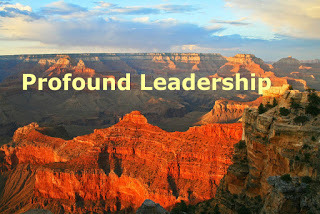“Leadership Master” Book Introduction Chapter 5 Profound Leadership
 At siloed industrial era, leadership effectiveness is perhaps dependent on the hierarchical level of authority and brute force style of command and control. However, now we live in a hyperconnected and over-complex digital ecosystem, digital flow changes the landscape of communication, collaboration and connection, command and control leadership style is no longer effective enough to make the influence and lead change smoothly. Because amplifying digital leadership is not about how loud you can speak, but how profound you could think. Digital leadership must go deeper, to touch the heart and mind, to practice the power of pull, to lead via influence, and to harmonize via positive thinking. In this chapter, we describe 13+ different leadership strengths to deepen leadership influence and enforce leadership effectiveness.
At siloed industrial era, leadership effectiveness is perhaps dependent on the hierarchical level of authority and brute force style of command and control. However, now we live in a hyperconnected and over-complex digital ecosystem, digital flow changes the landscape of communication, collaboration and connection, command and control leadership style is no longer effective enough to make the influence and lead change smoothly. Because amplifying digital leadership is not about how loud you can speak, but how profound you could think. Digital leadership must go deeper, to touch the heart and mind, to practice the power of pull, to lead via influence, and to harmonize via positive thinking. In this chapter, we describe 13+ different leadership strengths to deepen leadership influence and enforce leadership effectiveness.
Self-leadership: To know oneself is necessary to understand the filters and the bias. Self-reflection makes you more emphatic as a leader: Which quality makes you a strong leader? The advanced mindset or the exemplary behavior? The in-depth knowledge or profound wisdom? A leader’s individual journey is over the long haul and the goal should be to continually improve. From a strategic perspective, it’s also about planning, leadership at present is the missing link in business planning. Change, growth, self-leadership is the result and the ability to challenge oneself beyond the constraints of tradition. Self-leadership based on self-reflection and self-evaluation empowers us to be the change we want to see and lead change more effectively.
Gap-minding leadership: Leadership is about bridging today and future. There are all sorts of gaps need to be closed: Cognition gaps: In order to build a high-effective leadership team, foresightful organizations should always look for the complementary mindsets, capabilities, and skills that they don’t have so that they can build a winning team and complement each other. Generation Gaps: There is a surging need which is related to the realization that the gap is widening between the previously generation and the next generation, etc. The key to organizational success is to integrate next generation of leaders, tap into their way of looking at the world, solving problems with very collaborative working styles. Talent gap: Organizations not only need good managers to take care of today’s business but also have to grow the future leaders to leapfrog their companies for long-term prosperity.
 Change leadership: The world has changed significantly, and the speed of change is accelerating. Fundamentally leadership si about change and influencing people to change. There are differences between change management and change leadership. Change management which is the term refers to a set of basic tools or structures intended to keep any change effort under control, Change Leadership, on the other hand, concerns the driving forces, visions, and processes that fuel large-scale transformation. Leadership is about change management and also the ability to take initiative via change leadership.
Change leadership: The world has changed significantly, and the speed of change is accelerating. Fundamentally leadership si about change and influencing people to change. There are differences between change management and change leadership. Change management which is the term refers to a set of basic tools or structures intended to keep any change effort under control, Change Leadership, on the other hand, concerns the driving forces, visions, and processes that fuel large-scale transformation. Leadership is about change management and also the ability to take initiative via change leadership. Leadership is the ability to influence with or without authority. While there are many components of leadership, one of the most important ones is the ability to adapt, model and influence changes. Leadership becomes more open and omnipresent in the digital era because the hierarchy of an organization is flatter due to the latest digital disruption, the world has become more connected and transparent, effective leadership is based on its profundity, consistency, and the context of influence. Follow us at: @Pearl_Zhu
Published on June 18, 2016 23:45
No comments have been added yet.



